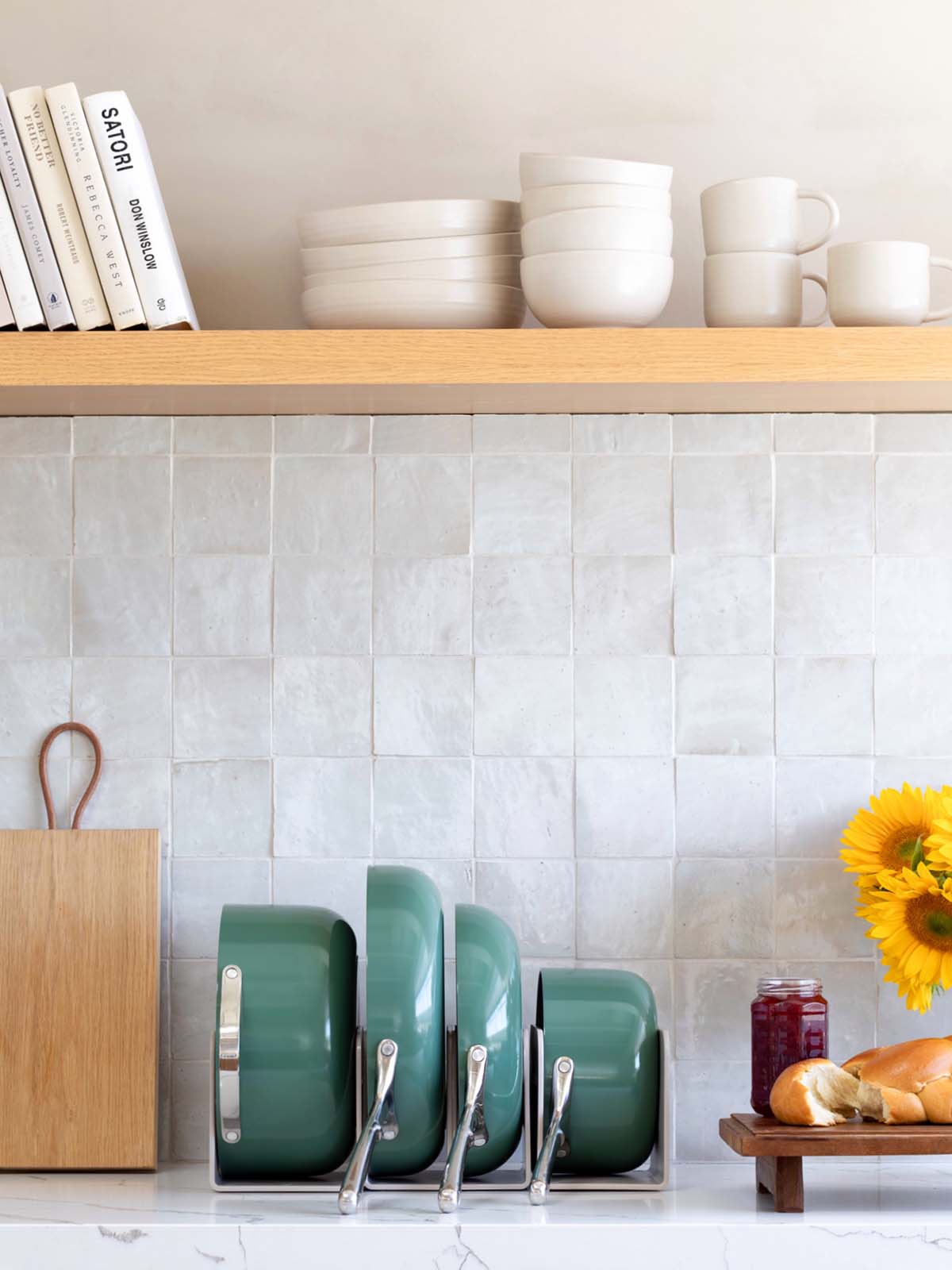[ad_1]
With their gorgeous clean lines, Caraway pots and pans look gorgeous in just about any kitchen, but are they really worth it? In this Caraway cookware review, we look at the basics behind ceramic nonstick, how well they perform in the kitchen, the good, the bad, and simple tips for cleaning, cooking, and storage.
Jump to What is it? | How is it different? | Cooking with Ceramic Pans | Good | Bad | Cleaning | Tips | Bottom Line | Common Questions

What is Caraway cookware?
Caraway Home makes ceramic nonstick cookware. These are aluminized steel pots and pans covered with a mineral-based coating which gives the pans a slick, nonstick surface.
You can purchase them as individual items, or cookware set or a bakeware set typically saves you a significant amount of money.
How is it different from other nonstick pans?
Approximately 95% of nonstick pans in the marketplace use PFOA and PTFE (Teflon) which are endocrine-disrupting “forever chemicals” (1). Researchers have expressed concern over their toxicity (2). When mistakenly overheated, pans made with these chemicals can also release toxic fumes that can potentially damage the lungs (3).
You should note that the FDA has not permitted the use of PFOA in cookware since 2013. Instead, newer Teflon pans now use similar chemicals called GenX. There’s emerging concern that GenX chemicals are also toxic (4).
By contrast, ceramic nonstick cookware is manufactured without these toxic chemicals. Instead, it relies on several layers of a mineral-based coating for a slick, nonstick surface. And it’s just about perfect for making notoriously “sticky” dishes such as scrambled eggs.
What’s it like to cook with Caraway pots and pans?
There’s a bit of a learning curve when it comes to using Caraway pots and pans. If you’re accustomed to using high heat, you’ll need to adjust to medium and low temperatures.
The pans heat very quickly and retain their heat better than most pans. Medium heat on a Caraway pan feels like cooking on moderately high heat in stainless steel. Once I got a feel for how rapidly they heat up (even at lower temperatures) and how well they maintain that heat, it was easy to adjust.
You’ll need to use much less cooking fat than in either stainless steel or cast iron cookware. If you add too much, it just pools in the pan. As someone who tends to cook with a lot of fat out of habit, it’s taken a conscious effort to pull back a bit, but it’s worth it.
These pans are so easy to clean. I make scrambled eggs for my 5-year old nearly every morning, and I tend to have to focus to prevent them from sticking to the pan (and creating a big mess I have to scrub out later). That means, if I get distracted in the kitchen, it’s all over.
With Caraway pots and pans, they come out clean every single time. Seriously. Food just glides off the pan, and then you rinse it and wipe it dry. The magnetic storage system that comes with the cookware set also means everything packs up into the cupboard nicely.
The Good
There are tens of thousands of customer reviews of Caraway products, and the vast majority of them are positive. Overall, among its greatest benefits are that it’s nonstick, nontoxic, and doesn’t leach.
- It truly is nonstick. Fried eggs slip onto the plate with a tilt of the pan. Sticky sauces roll out without leaving a drop.
- It’s easy to clean. Because caraway pots and pans truly are nonstick, they’re also easy to clean. In fact, they practically clean themselves. All you need to do is run a little water over them, and give them a wipe with a soft sponge or kitchen towel. That’s it.
- They’re free of toxic chemicals such as PTFE and PFOA as well as heavy metals such as lead, cadmium, and nickel.
- Caraway pans are rigorously tested, and third-party tests show that not only are they free from heavy metals and endocrine-disrupting chemicals typically found in nonstick cookware, but they also do not leach.
- They come with an easy storage solution. The magnetic pan organizers are genius. They help keep the cookware from scratching during storage and make it really easy to store and access the pans you need.
- They’re gorgeous. In addition to being both functional and practical, the pans are beautiful. They have a clean, modern aesthetic, and nice lines. They also come in a wide variety of colors.
The Bad
While most of the reviews are positive, there are a few drawbacks to Caraway pots and pans. Namely, they require a fair amount of babying, and it’s tough to cook some things – especially those that require high heat.
- It’s tough to get good sear. In order to preserve the nonstick coating, you’ll need to keep things at low- to medium heat which is typically too low to sear meats. So you’ll want to keep at least one cast iron or stainless steel pan around for those high-heat applications.
- It’s a little pricy compared to other nonstick cookware sets (but, again, those typically contain endocrine-disrupting chemicals). With a price tag of $395 for a full set, it’s comparable to other nontoxic cookware such as high-end stainless steel. It’s much less expensive than enameled cast iron sets.
- They’re a little fussy. You have to treat them gently, watch the temperature, use nonmetal tools, and handwash the pans in order to care for them.
- They’ll eventually need to be replaced. High-quality stainless steel cookware can last a lifetime, and cast iron cookware can last for generations. But ceramic nonstick will eventually need to be replaced. If you treat the pans well and follow their care and cleaning guidelines, they should last for several years.
- Some users report staining. While my pans have maintained their color beautifully, some people report minor staining on the exterior of the pans. You might opt for darker-colored pans.
How to clean your Caraway pots and pans
Caraway pots and pans are easy to clean. While my stainless steel and cast iron pans can require a little scrubbing and occasional elbow grease, ceramic nonstick pots and pans take no effort.
The food slips off so easily that the pans practically clean themselves. You can rinse them under the faucet, wipe them with a soft sponge, and dry them with a kitchen towel. Then pack them away in the magnetic organizers that come with a set to prevent abrasions and scratches during storage.
Tips for caring for and using ceramic nonstick cookware
In order to keep your pans in good condition (and maintain that ceramic coating), you’ll want to take particular care of them. They can be a little fussy and need a gentle hand, careful storage, and light heat. As long as you stick to these rules, they should last a long time.
- Only cook on low- to medium-heat (except when boiling water or simmering soup). High heat can damage the pans and their nonstick coating over time.
- Oven heat should never exceed 550 F. But, honestly, who’s cooking at such high heat in a home kitchen anyway?
- Ditch the cooking sprays. Cooking sprays can damage the ceramic coating. Instead, use a little bit of fat such as olive oil or butter in the pan.
- Use gentle cooking tools such as wooden spoons or silicone spatulas. Metal tools and anything with a sharp edge can scratch the ceramic coating.
- Let the pans cool completely before cleaning them. Cleaning a hot pan under cold water can shock the pan, reducing long-term durability.
- Handwash the pans with a little water, a few drops of dish soap, and a soft sponge. They’re super easy to clean since nothing sticks.
- Store them carefully. Stacking pans can scratch the ceramic surface, so use magnetic organizers that come with your set.
Bottom Line: Is Caraway worth it?
As a die-hard lover of cast iron and stainless steel, I felt a little wary of ceramic nonstick pans. I tried the Instagram-famous Always Pan and didn’t really care for it, and I gave away my Green Pan.
But, I do like Caraway. A lot.
And I’m itching to get my hands on their bakeware set (would love to see my mini-frittatas slip out of a muffin tin as easily as fried egg slips out of the Caraway frying pan.
It’s good for people who don’t have a lot of time to scrub pots and pans since the clean-up is so easy. And it’s worth it if you’re willing (and able) to treat the pans gently.
If you’re rough with your kitchen gear, or always cook on high heat, you might want to skip ceramic nonstick.
If you’re currently using conventional Teflon-coated nonstick pans, I’d drop them in an instant and switch to ceramic nonstick or high-quality stainless steel.
If you’re currently using stainless steel or cast iron, it might be worth picking up a pan or two for those particularly sticky dishes.
If you need to replace (or purchase) a whole cookware set, it’s worth looking into ceramic nonstick. They work so well with a little care. But, you’ll still need a good cast iron frying pan for high-heat applications.
Common Questions
Caraway cookware is sold online directly through their website. It is also available through select retailers such as Bed Bath and Beyond and Target.
They are manufactured in China at facilities that employ strict manufacturing standards including environmentally-friendly processes and the ethical treatment of workers.
Caraway offers a 1-year warranty on their bakeware, pots, and pans. With careful use and gentle handling, the pans last for several years.
According to Caraway’s website, the pans are aluminum-core pans coated with a mineral-based nonstick ceramic that is free from PTFE, PFOA, lead, cadmium, and other toxic materials. Their handles are stainless steel.
If you purchase a cookware set or a bakeware set, it will come with organizers that help you store the pots, pans, lids, and bakeware. Their storage system includes magnetic pot and pan organizers, and a lid organizer that you can hang or store in a drawer. Their bakeware also includes a storage organizer to stack your sheet pans, cake tins, and loaf pans.
Yes. Both Caraway cookware and bakeware are oven-safe up to 550F; however, you should generally use low to medium heat when cooking on the stove.
No. Dishwashers are highly abrasive and can wear away the ceramic nonstick coating on Caraway pans.
Yes. While it’s recommended to use the pans only on low to medium heat, boiling is an exception. That’s because, due to the high water content, the temperature in the pan will never exceed 212 F as it can sometimes do with frying and sautéing.
So feel free to boil water and simmer soups in your ceramic nonstick pots, but keep to lower temperatures when using sautéing, pan-roasting, and frying.
What to cook in your Caraway pots and pans
References
- Chaparro-Ortega, Andrea et al. “Endocrine disruptor effect of perfluorooctane sulfonic acid (PFOS) and perfluorooctanoic acid (PFOA) on porcine ovarian cell steroidogenesis.” Toxicology in vitro : an international journal published in association with BIBRA vol. 46 (2018)
- Sajid, Muhammad, and Muhammad Ilyas. “PTFE-coated non-stick cookware and toxicity concerns: a perspective.” Environmental science and pollution research international vol. 24,30 (2017)
- Shimizu, Taro et al. “Polymer fume fever.” BMJ case reports vol. 2012 bcr2012007790. 10 Dec. 2012
- Human Health Toxicity Assessments for GenX Chemicals. EPA. Accessed 2022.
[ad_2]
Source link

